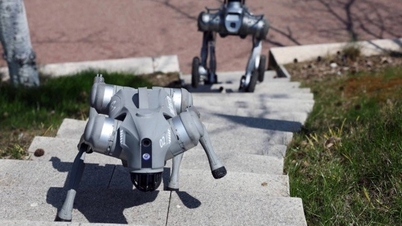
New research: Humanoid robots can lift objects 4,000 times heavier than their body weight (Illustration: livescience).
For the first time, scientists have successfully solved the difficult problem of balancing flexibility and strength in artificial muscle design. The groundbreaking research results were published in the journal Advanced Functional Materials on September 7.
Professor Hoon Eui Jeong, a mechanical engineering expert at Ulsan National Institute of Science and Technology (UNIST) and lead author of the study, emphasized: "This research has overcome the fundamental limitation of conventional artificial muscles, which can only be highly stretchable but weak, or strong but stiff. Our composite material can do both, opening the door to more flexible soft robots, wearable devices and intuitive human-machine interfaces."
Artificial muscles are often limited by their flexibility or stiffness. They need to be stretchable while still providing sufficient power output, otherwise their activity density will be limited. However, soft artificial muscles are prized for their variability due to their light weight, mechanical adaptability, and ability to transmit multidirectional (movement) actuators.
Work density, or the amount of energy per unit volume a muscle can deliver, is a major challenge for artificial muscles. Achieving high values along with high contractility is a goal that scientists are always striving for.
The new artificial muscle is described as a “high-performance magnetic composite actuator,” a complex chemical combination of polymers bonded together to mimic the pull and release forces of muscle. One of these polymers can vary in stiffness and is embedded in a matrix containing magnetic microparticles on its surface, which can also be controlled. This allows the muscle to be actuated and controlled, producing movement.
The new design incorporates two distinct cross-linking mechanisms: a covalent chemical network (two or more atoms share electrons to achieve a more stable configuration) and a reversible physical interaction network. These two mechanisms provide the muscle with the strength to perform over time.
The balance between stiffness and elasticity is effectively resolved by the double cross-linked architecture. The physical network is further strengthened by incorporating a type of microparticle (NdFeB) on the mechanical surface, which can be further functionalized via a colorless liquid (octadecyltrichlorosilane). These particles are dispersed throughout the polymer matrix.
The synthetic muscle stiffens under heavy loads and softens when it needs to contract. In its stiff state, the artificial muscle, which weighs just 1.13 grams, can withstand a weight of up to 5 kilograms, or about 4,400 times its own weight.
The researchers say that human muscles contract at around 40% tension, but the synthetic muscle reached 86.4% tension – twice as much as human muscle. This allowed for a work density of 1,150 kilojoules per cubic meter – 30 times higher than what human tissue is capable of.
The team conducted uniaxial tensile tests to measure the strength of the artificial muscle, applying a pulling force to an object until it broke to find the maximum tensile strength.
Experts say this breakthrough opens up prospects for many fields, from soft robotics, medical rehabilitation, to smart wearable devices and human-machine interfaces.
With the ability to be both flexible and powerful, the new generation of artificial muscles can help robots move more gracefully, while also precisely supporting human movements in sophisticated biomedical and industrial applications.
Source: https://dantri.com.vn/khoa-hoc/phat-trien-co-nhan-tao-nang-vat-nang-gap-4400-lan-trong-luong-20251104053327548.htm



![[Photo] Opening of the 14th Conference of the 13th Party Central Committee](https://vphoto.vietnam.vn/thumb/1200x675/vietnam/resource/IMAGE/2025/11/05/1762310995216_a5-bnd-5742-5255-jpg.webp)
































![[Photo] Panorama of the Patriotic Emulation Congress of Nhan Dan Newspaper for the period 2025-2030](https://vphoto.vietnam.vn/thumb/1200x675/vietnam/resource/IMAGE/2025/11/04/1762252775462_ndo_br_dhthiduayeuncbaond-6125-jpg.webp)










































































Comment (0)